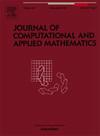Cahn-Hilliard方程迭代法的谱半径及其与分裂技术的关系
IF 2.1
2区 数学
Q1 MATHEMATICS, APPLIED
Journal of Computational and Applied Mathematics
Pub Date : 2025-04-12
DOI:10.1016/j.cam.2025.116673
引用次数: 0
摘要
本文对Cahn-Hilliard方程隐式格式的稳定性进行了数值研究。Cahn-Hilliard方程对于数值格式有一个额外的限制:总自由能必须不随时间增加。对于这个问题,最流行的补救方法之一是分裂技术,将比自由能分成两部分,其中一部分是显式处理,另一部分是隐式处理。我们分析了这种方法与Jacobi和Gauss-Seidel方法的谱半径的关系,并表明线性分裂会导致数值算法的恶化。我们还指出将Cahn-Hilliard方程直接视为单个四阶方程或将其视为两个二阶方程的系统之间的区别。我们提出了一种简单的方法,通过增加稳定项来控制谱半径并增加迭代方法的稳定性,相当于增加化学势的人工时间导数。本文章由计算机程序翻译,如有差异,请以英文原文为准。
The spectral radius of iterative methods for the Cahn–Hilliard equation and its relation to the splitting technique
We numerically study the stability of implicit schemes for the Cahn–Hilliard equation. The Cahn–Hilliard equation has an extra limitation for numerical schemes: the total free energy has to be non-increasing with time. One of the most popular remedies for this problem is the splitting technique, when the specific free energy is divided into two parts, one of them is treated explicitly and other one is treated implicitly. We analyse this approach in relation to the spectral radius in the case of Jacobi and Gauss–Seidel methods and show that the linear splitting can lead to the deterioration of a numerical algorithm. We also point out the difference between considering the Cahn–Hilliard equation straightforwardly as the single equation of the 4th order or as the system of two equations of the 2nd order. We propose a simple method to control the spectral radius and increase the stability of iterative methods by adding a stabilizing term, equivalent to adding the artificial time derivative of the chemical potential.
求助全文
通过发布文献求助,成功后即可免费获取论文全文。
去求助
来源期刊
CiteScore
5.40
自引率
4.20%
发文量
437
审稿时长
3.0 months
期刊介绍:
The Journal of Computational and Applied Mathematics publishes original papers of high scientific value in all areas of computational and applied mathematics. The main interest of the Journal is in papers that describe and analyze new computational techniques for solving scientific or engineering problems. Also the improved analysis, including the effectiveness and applicability, of existing methods and algorithms is of importance. The computational efficiency (e.g. the convergence, stability, accuracy, ...) should be proved and illustrated by nontrivial numerical examples. Papers describing only variants of existing methods, without adding significant new computational properties are not of interest.
The audience consists of: applied mathematicians, numerical analysts, computational scientists and engineers.

 求助内容:
求助内容: 应助结果提醒方式:
应助结果提醒方式:


